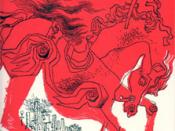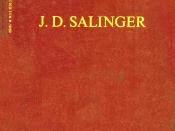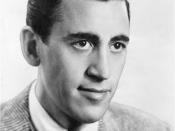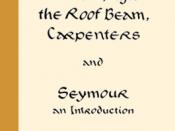J.D. Salinger responded to the almost ridiculous success of his only novel, The Catcher in the Rye, in an unorthodox manner. After achieving the almost unheard of coup of generating enormous sales and receiving almost universal critical acclaim, or at the very least attention, Salinger elected to move entirely away from the character with whom millions of readers were able to identify, Holden Caulfield, and to spend the bulk of his remaining fifteen years as a public writer focusing on a collection of stories about a family who are about as unreachable as the goddamn moon is to the average person. Although it is common for writers to frequently add and drop whole sets of characters, Holden seemed to be somewhat of a masterpiece, and by all appearances Salinger was very comfortable writing about him, which is why his choice to work with a set of characters who create a large number of problems is surprising.
While The Catcher in the Rye is undeniably Salinger's masterpiece, the Glass Stories seem to be his principal mission, his quest as a writer, and perhaps are his most intriguing works.
Salinger had already begun toying with the Glasses prior to the publication in 1951 of The Catcher in the Rye, with "A Perfect Day for Bananafish" first appearing in print, in The New Yorker in 1948. Of the seven stories Salinger wrote about the Glass family in the subsequent seventeen year span leading up to the cessation of his production of stories for public consumption, four, plus "A Perfect Day for Bananafish," present problematic issues in the overall discussion surrounding the work of this unprolific American writer. The four, which will be the recipients of generous print in the coming pages, are "Raise High the Roof Beam Carpenters," published in 1955, "Zooey," 1957, "Seymour: An Introduction," 1959, and "Hapworth 16, 1924," Salinger's final appearance in print to date, published in 1965. All appeared in The New Yorker, and with the exception of the last, were later published as books. These stories were quite within the American literary tradition at the outset, but slowly moved away from it, ending with "Hapworth," which is about as untraditional a narrative as can be found among the works of authors who have enjoyed any amount of popular success.
The Glass stories present a number of problems to readers expecting Salinger to write in a straightforward narrative as he did in The Catcher in the Rye. The first problem readers will deal with is that Salinger is not the author of these stories. As we find out for the first time in "Raise High the Roof Beam, Carpenters," the stories are written by the second-eldest of the seven Glass children, the short story writer Buddy Glass. In reality, of course, the stories are the work of Salinger. When he designated the authorship of the Glass corpus to a sort of alter-ego, Salinger served notice that his work from that point on would be a departure from The Catcher in the Rye. Since Buddy is a literary stand-in for Salinger, we can trace the path of Salinger's progress as a writer by Buddy's over the span of these stories.
There are a couple areas of focus in the Glass stories. Although there are nine members of the Glass family, this series is truly the story of Seymour and Buddy Glass, the two eldest children in the family. This holds true even in the stories "Franny," and "Zooey," during which neither Seymour or Buddy make a physical appearance. Both Seymour and Buddy are exceptionally intelligent, and have been concerned with spirituality from an absurdly young age. Seymour was on a personal quest for God through most of his life, but it went awry at some point, and he ended up committing suicide at the age of thirty-one. We find out in "Hapworth" that Seymour was well aware that he would be dying young, even at the age of seven, which was his age when the letter ("Hapworth" is a letter from Seymour, deposed in a summer camp, to his family) was written. Buddy's concern with these stories is to come to grips with his older brother's spiritual failure and physical death. He is also attempting to develop as a writer in the manner which Seymour prescribed for him, which is to write "what piece of writing in all the world Buddy Glass would most want to read if he had his heart's choice" ("Introduction," p.161). His development into a writer of unconventional narratives mirrors Salinger's own. Buddy's development as a writer hinges on Seymour, and his quest to understand what caused him to quit living. Two years Buddy's elder, Seymour grew up as his younger brother's spiritual and intellectual guide. While Buddy is an intellectual force in his own right, as evidenced by an anecdote in "Hapworth" in which Buddy is depicted memorizing an entire book in forty-five minutes in order to win study hall rights for himself and Seymour (the Glass children, as I will describe in more detail later, have exceptional powers of mental recall), he was influenced heavily by his older brother, and at some points appears to almost worship him. This is especially true in the earlier Glass stories, such as "Raise High the Roof Beam, Carpenters," during the early portion of which, as Eberhard Alsen points out, "Buddy would like to see his older brother as a near-saint and does not want to acknowledge his negative traits" (Alsen, 38). To fully understand the impact Seymour had on Buddy and his writing is essential to an intelligent reading of the Glass stories, and since it is such a central issue, I feel it is necessary to put in a sizable quotation here that wasn't written by either Salinger or Buddy, but rather included in the opening pages of "Raise High the Roof Beam, Carpenters," and which explains to a large degree the relationship between the two brothers. As introduced by Buddy, it is a Taoist tale which Seymour once read to Franny: Duke Mu of Chin said to Po Lo: "You are now advanced in years. Is there any Member of your family whom I could employ to look for horses in your stead?" Po Lo replied: "A good horse can be picked out by its general build and appearance. But the superlative horse-one that raises no dust and leaves no tracks-is something evanescent and fleeting, elusive as thin air. The talents of my sons lie on a lower plane altogether; they can tell a good horse when they see one, but they cannot tell a superlative horse. I have a friend, however, one Chiu-fang Kao, a hawker of fuel and vegetables, who in things appertaining to horses is nowise my inferior. Pray see him." Duke Mu did so, and subsequently dispatched him on the quest for a steed. Three months later, he returned with the news that he had found one. "It is now in Shach'iu," he added. "What kind of a horse is it?" asked the Duke. "Oh, it is a dun-colored mare," was the reply. However, someone being sent to fetch it, the animal turned out to be a coal-black stallion! Much displeased, the Duke sent for Po Lo. "That friend of yours," he said, "whom I commissioned to look for a horse, has made a fine mess of it. Why, he cannot even distinguish a beast's color or sex! What on earth can he know about horses?" Po Lo heaved a sigh of satisfaction. "Has he really got as far as that?" he cried. "Ah, then he is worth ten thousand of me put together. There is no comparison between us. What Kao keeps in view is the spiritual mechanism. In making sure of the essential, he forgets the homely details; intent on the inward qualities, he loses sight of the external. He sees what he wants to see, and not what he does not want to see. He looks at the things he ought to look at. So clever a judge of horses is Kao, that he has it in him to judge something much better than horses." When the horse arrived, it turned out indeed to be a superlative animal.
To this, Buddy adds, "Since the bridegroom's (Seymour's) permanent retirement from the scene, I haven't been able to think of anybody whom I'd care to send out to look for horses in his stead" (4-6). This sufficiently explains the feelings Buddy has about his brother and his untimely exit from the world. This is the point of departure from which Buddy embarks on his search for a less conventional narrative.
Seymour was a teacher when he had a job, and he was the family's teacher, too. He set up extensive spiritual learning programs for Buddy, and later with Buddy's help, for Zooey and Franny, the two youngest Glass children, which turned out to be instrumental in making his pupils have a difficult time interacting with less educated people. As Zooey says, "We're freaksâ¦and both those bastards are responsibleâ¦I swear to you, I could murder them both without even batting an eyelash. The great teachers. My God" ("Zooey," 138). Buddy, despite helping teach Franny and Zooey to be freaks mentally, learned from Seymour, and does not at all want to think of him as a negative influence.
As the Glass stories progress and Buddy works everything out in his writing, he comes slowly to understand that Seymour was no saint, and in "Zooey," according to Alsen, he "makes the point that Seymour, despite his best intentions, had a very negative influence on his siblings" (48). It is through examination of this realization that Buddy comes to an understanding, by the time that "Hapworth" is discovered seventeen years after Seymour's death, of what went wrong in Seymour's quest for God. Buddy's understanding of his brother comes in increments and runs parallel with his development as a writer from the heart instead of the head. Buddy's ultimate ambition as a writer is to write stories spontaneously, with no preconceived notion of what the point might be, and with a small, specific audience in mind. This is the type of writing which Seymour, a truly great poet if we are to believe what Buddy tells us in "Seymour: An Introduction," espouses, and so we see that even long after his death, Seymour continues to have an immense impact on the life and profession of his younger brother.
Buddy does in fact narrow his audience as the series progresses, which is a large problem for the casual reader. On the dedication page of the book edition of Raise High the Roof Beam, Carpenters and Seymour: An Introduction, Buddy says, "If there is an amateur reader still left in the world-or anybody who just reads and runs-I ask him with untellable affection and gratitude, to split the dedication of this book four ways with my wife and children" (Salinger). This is a misleading introduction, for the two stories contained within represent a definite assembling of a tent in the camp of literature for the invested reader. To truly understand what is happening in these stories, particularly the second, a reader must not only dig through an enormous amount of Buddy's own seemingly trivial detail, but also be familiar with, among other things, Eastern religious philosophy, Japanese and Chinese poetry, and the previous installations in the Glass series. It is a lot for the author to ask of an "amateur reader," but that is part of what Buddy does as his writing develops, in order to narrow his audience down to those who will understand and take interest.
The biggest problem for readers may be identifying with the characters Salinger has created. They are themselves exceptionally problematic. Since Buddy is himself a character, I will discuss this section describing Salinger, not him, as the narrator. Salinger portrays the Glass children as if they are really made of glass, so the family name is fitting. They are very breakable, due to their desire to not be so outrageously separated from the bulk of society by their intellect. As Seymour writes in "Hapworth," "I am hopingâ¦that by striving each day to reduce general snottiness, surface conceits, and too damn much emotion, coupled with several other qualities quite rotten to the core, we will antagonize and inspire less murder, on sight or repute alone, in the hearts of fellow human beings" (34). It is unnecessary for Seymour to think this way, for Salinger would never allow anybody outside the family itself to do any real harm to one of its members, for the simple fact that in his mind they are too perfectly created. John Updike points out, in a rather critical review of Franny and Zooey, that they begin to carry a certain air of ethereality about them, as "the seven Glass children melt indistinguishably together in an impossible radiance of personal beauty and intelligence" (Laser, 229). They do in fact seem as if they were made to be placed on a mantle, and Salinger does nothing to dispel this notion-the stories, especially "Zooey" take place in intensely described and detailed rooms, with very little action ever occurring-as if the characters were discussing matters from a designated spot which they could be moved from only by their caretaker-Salinger-and not of their own will. In a sense, and taking full advantage of the many possibilities for abusing their name, they are Salinger's glass menagerie.
The Glasses can be harmed, as evidenced by Franny's nervous breakdown. Lane Coutell, her simply average boyfriend, nudges her slowly from the precarious ledge on which she dangles, in the story named after her. Although she falls-literally, when she faints at the story's close-and breaks, at least mentally, it is okay, because Zooey is there to pick up the pieces and put her back together. It is excusable for Lane to have precipitated this collapse, for he does it unintentionally, and he is, after all, "just one of the remote millions coarse and foolish enough to be born outside the Glass family" (Laser, 229). The breakdown he prods along seems to have been long overdue in Franny, and as Zooey describes it, it is "a tenth rate nervous breakdown," anyway. It is more excusable than Seymour's action in "A Perfect Day For Bananafish." As we learn for the first time in "Raise High the Roof Beam, Carpenters," the Glass children all appeared weekly on a radio program called "It's a Wise Child." They are, then, somewhat along the lines of celebrities. The world adored them all when they were young, and this serves as another trick by Salinger to make them untouchable and difficult to identify with. While in The Catcher in the Rye, Holden is one of the easiest characters in modern fiction to identify with on a personal level-everyone has at least one opinion in common with him-the Glass children are polar opposites, being as hard to connect with for the average person as any inanimate household decoration.
Salinger builds up the intellects and personalities of the Glass children to such a degree that the line of communication between imagination and reality is snapped, allowing them to go drifting off into a blissful land of verbal pyrotechnics, virtually impossible reading diets and photographic memories. As Zooey points out, "On top of everything elseâ¦we've got 'Wise Child' complexes. We never really got off the goddam air. Not one of us. We don't talk, we hold forth. We don't converse, we expoundâ¦" (Zooey, 139). In short, they are different than almost anyone they will ever meet, which leaves them in a position of going through life at a fairly lonely clip. In order to return from the aforementioned "Land of Glass," a journey which must be made whenever normal conversation is required of any of them, a process is required which involves the reconnecting of the line of communication which Salinger has snapped, an operation which resembles an electrical cord, continually more frayed, being dragged by boat across the expanse of water separating the Glasses from reality, where it must be plugged in. Inevitably, the cord will be dropped and someone will pay the price. In Seymour's case, the price is his life, as portrayed in "A Perfect Day For Bananafish." Chronologically, this story is the first in the Glass series. It would be wise to insert here a note about the chronology of the series, since it is relatively important. It is with chronology that Salinger, through Buddy, makes one of his most significant challenges against the system of traditional narrative. It also creates a problem for the new reader of the Glass stories. Buddy starts out with an account of the most important event in the family, the suicide of Seymour, which occurred in 1948. He assumes from the start that the reader knows things which won't be found out until much, much later in the series. The next story, "Franny," takes place in the mid 1950's. After "Franny" comes "Carpenters," which deals with Seymour's wedding day way back in 1942, and then Buddy jumps right back to the day after the events occurring in "Franny," for its solution, "Zooey." After this comes "Seymour: An Introduction," which is not even a story, but rather an extended introduction to the life of Seymour as a whole, and his poetry in specific. Thus, the introduction comes a full three stories after the death of the character who is being introduced. Finally, "Hapworth 16, 1924" comes along as the final installment to date in the series, and is introduced simply as a long letter from Seymour to the family, written from a summer camp, when he was seven years old. Reading the stories in order today is no problem, but when "A Perfect Day for Bananafish" appeared in 1948, there were many essential things about Seymour which readers could not have understood until the end of the series, seventeen years later. This is a major challenge put on the reader. With some discussion of the stories themselves, though, it becomes more clear what Salinger, or Buddy rather, was doing.
"A Perfect Day for Bananafish" is mainly a traditional short story. When it was written, Salinger in all likelihood didn't yet have a plan for the Glass family. The story is short and direct, one of the "rattling good stories" which Seymour advises Buddy to avoid ("Introduction," 180). It begins with a conversation between Seymour's wife and mother-in-law about his instability, during which his wife, Muriel, claims, "Mother, you talk about him as though he were a raving maniacâ¦" (Nine Stories, 9). The scene then shifts to the beach, where Seymour is shown entertaining a young girl, with great skill in the handling of children: "Did you read 'Little Black Sambo?" she said.
"Its very funny you ask me that," he said. "It so happens I just finished reading it last night." He reached down and took back Sybil's hand. "What did you think of it?" he asked her. "Did the tigers run all around that tree?" "I thought they'd never stop. I never saw so many tigers." "There were only six," Sybil said.
"Only six!" said the young man. "Do you call that only?" (N.S. 14).
This exchange belies Muriel's mother's characterization of Seymour as a "raving maniac," but shortly before this, he had answered Sybil's simple question, "Are you going in the water?" with the strange, in context, "I'm seriously considering it. I'm giving it plenty of thought, Sybil, you'll be glad to know" (N.S. 12). This comment is significantly out of place, and this points us toward the story's conclusion, which on first read is as shocking as an uninhibited reading of Shirley Jackson's "The Lottery." Seymour returns from the beach to the room, where his wife lays asleep. "He glanced at the girl lying asleep on one of the twin bedsâ¦Then he went over and sat down on the unoccupied twin bed, looked at the girl, aimed the pistol, and fired a bullet through his right temple" (N.S. 18).
So the story ends, and so begins the Glass saga. The ending is shocking because Buddy, as narrator, files the reader right past the myriad clues to Seymour's eventual suicide. By writing so as to make the reader miss these clues, Buddy turns even the most discerning literary types (such as myself) into the "amateur reader" of whom much has been spoken. The remainder of the Glass stories are concerned, at least stylistically, with moving away from this format of "rattling good stories" which turn the reader into an amateur by way of careful set-up, and instead creating amateurs by way of the elaborate sprawl and detail which the reader is asked to wade through in order to find the thread of narrative, and the issues which are raised. Although trying at times, it is a pleasure to do so, in the end.
There are three more Glass stories between "Bananafish" and the beginning of Buddy's search for a new narrative, but they bear only a slight relation to the main body of text concerning the family, and so they will not be studied here. They are, for the interested reader, "Uncle Wiggily in Connecticut," "Down at the Dinghy," and "Franny." The latter actually does relate strongly to the main Glass stories, but everything which occurs there is rehashed in "Zooey," and so does not really require a section of its own. So these three stories, despite their quality, are doomed to be ignored in the discussion of the Glass stories as a quest by Buddy for a good narrative, and by Seymour, for God.
"Raise High the Roof Beam, Carpenters" is the first of the Glass stories to take a departure from the traditional short story formula. Although the story has a definite beginning, middle and end, what fills up the remainder is somewhat unusual. To begin with, the story is told in first person. It is Buddy's relation of the events which occurred on Seymour's wedding day in 1942, told thirteen years later, after Seymour has been dead for seven years. The position of the narrator, therefore, is confusing, for one can't tell clearly whether Buddy is telling the story as he felt it on the day in question, or if he is telling it after careful review of what transpired that day and with the knowledge in hand of what happened in the following years. In addition, the story appears from the outset to be a story about Seymour Glass, but he never once makes a physical appearance, leading one to believe that this is actually a story about Buddy Glass. If the latter is true, then we must presume that "Carpenters" is concerned with Buddy's quest for understanding of his brother's death, rather than Seymour's quest for God. This would settle the first question raised, since it would assume that Buddy, in trying to cope with his brother's early exit, is writing this story with the knowledge that the suicide has happened.
As far as story goes in "Carpenters," the scene takes place after Seymour has failed to show up for his wedding. Buddy, the only Glass family member to make it to the wedding (the others all have believable excuses), somehow ends up in a car with members of the bride's party, including an outraged and outspoken bridesmaid. Despite his attempts to keep a low profile, since he is related to the persona non grata, Buddy eventually feels compelled to defend his brother at least to some degree, and it comes out that he is Seymour's brother. Eventually, the whole group inhabiting the car end up at Seymour and Buddy's old apartment, where the story's purpose becomes clear at last. It seems as if Buddy is trying to come to terms with why his brother, a very spiritual man, would ever marry someone as materialistic as his bride, Muriel Fedder. He is obviously disturbed by this, since after discovering and reading Seymour's diary and realizing that Seymour is well aware of her materialism and in fact is marrying her partly for that reason, Buddy, a non-drinker, impulsively tosses down four straight shots of scotch. Eventually, the bridesmaid makes a phone call and reports that Seymour has arrived at the Fedders' home and eloped with his bride, and suddenly everything is okay. Shortly following the exit of the formerly hostile crowd, Buddy comes to an understanding that Seymour needs Muriel's materialism as much as she needs his spirituality. When Buddy realizes this, he falls asleep, a sure sign that he has reached peace of mind, or maybe just had too much alcohol. At any rate, this is the first time Buddy shows any signs of being aware that Seymour's quest for God and spiritual advancement had ultimately failed. It is also the first story in which we hear the unmistakable voice of Buddy as narrator. This comes through even more clearly in "Zooey." According to Eberhard Alsen, "The structure of the story ("Zooey") shows that Buddy is deliberately going beyond the tradition of conventional short fiction" (60-61). Buddy describes "Zooey" as not a short story at all, but rather a "prose home movie," and a "multiple love story, pure and complicated." As for the style of language, Buddy describes it as "a kind of esoteric, family language, a sort of semantic geometry in which the shortest distance between any two points is a fullish circle" ("Zooey," 49). So we find that in terms of the discussion of Buddy and Seymour, this story is an extension of Buddy's attempts to write unconventional narratives. It is in this story that Buddy begins to bury things behind a wall of seemingly trivial detail. It is only after considerable rereading that one reaches a decision as to what the story is about.
To me, it is a depiction of the aftermath of Seymour's and Buddy's attempts to educate Franny and Zooey, the two youngest members of the family. Franny has experienced a spiritual crisis and a nervous breakdown, and returned home from college to recuperate. Zooey is there and tries to talk to her but ends up doing more harm than good, until the final scene, in which he and Franny both come to a realization that what Seymour and Buddy have done is make them unable to tolerate people who aren't as well-educated and steeped in spirituality as they themselves are. Once they realize this, it is a short step for them to the idea that "in order to serve God, they must learn to serve people" (Alsen, 57). When this is understood, Franny's crisis is solved, and she goes off into a peaceful sleep, with bravo all around in Zooey's general direction. With the way "Zooey" ends, it is clear that "Buddy still has not understood why Seymour's life ended in suicide" (Alsen, 60). This leads us to "Seymour: An Introduction," in which Buddy comes close to a full understanding.
With "Seymour: An Introduction," Buddy Glass goes off the deep end, writing very much from the heart as Seymour advocated, and Salinger almost loses his audience. The fact is, this story is plain hard to read. Buddy is unable "to look after the reader's most immediate want; namely to see the author get the hell on with his story." Aware that what he is writing is not a story that will flow nicely but a series of descriptions and digressions, Buddy offers the reader a "bouquet of very early-blooming parentheses: (((())))." Buddy keeps up a running dialogue, along these lines, of his progress in writing the story, and continually begs the reader's pardon, only to rescind that request almost immediately. He is obviously coming to grips with the idea that he has reached the point where he is writing for himself, and a very, very limited audience, just as Seymour suggested he should.
What we find is that when Buddy does reach this pinnacle of sorts, he ends up writing not a story but a description, if even that, that wanders, digresses, quotes and confounds more than anyone would ever have expected at the beginning of the series, upon reading "A Perfect Day for Bananafish." "Introduction" is beautiful writing, with humorous anecdotes and pretty little windows into the world of Eastern philosophy, but it won't be understood except by the most specialized of readers. Buddy has, however, finally achieved his goal of writing an unconventional story. He offers more of the same in "Hapworth 16, 1924." Although it is not written by Buddy but rather Seymour, it is in the same style as "Introduction," and illustrates clearly where Seymour got the idea in the first place for how Buddy ought to write. Although the prose is not as good as in "Introduction," and "Hapworth" is really a minor work, it is here, upon reading his brother's impassioned writing (Seymour writes, "My personal instability and too much emotion will ever be plainly marked in every stroke of the pen, quite unfortunately") that Buddy finally fully understands that his brother's quest for God failed, and that is why he committed suicide. With this realization, the Glass stories come to a close.
With the Glass stories ends the publishing career of one of the most talented writers of the last century. J.D. Salinger, despite retiring from the public thirty-five years ago, (or perhaps because of it) remains very much in the public consciousness, and is still popular in the bookstores. To anyone who paid close attention to the trajectory of the Glass stories, in particular "Seymour: An Introduction," and "Hapworth 16, 1924," Salinger's disappearance is no great surprise. As he says in "Hapworth," "Let God raise one human being up over another, lavishing handsome favors upon him, and the hour has struck to leave his charming service forever, and quite good riddance" (65). Perhaps Salinger felt that the acclaim he received publicly and critically were raising him above the rest in an unjustifiable manner, and he felt that he needed to avoid that if he were to remain in God's service. Or perhaps he just likes Cornish, New Hampshire, where he lives, an awful lot, and is simply unwilling to give up his vegetable garden just for the sake of writing some stories. It doesn't matter too much what the correct answer is. When he worries, "there is always a slight, magnificent, utterly worthwhile risk that I will be a crashing failure from the word go, disappointing all my friends and loved ones," he has no need to worry, for no matter what else he has or hasn't done, with the Glass family and with Holden Caulfield he created utterly worthwhile characters who have a permanent place in American literature ("Hapworth," 65). If that is a disappointment, then so be it.





